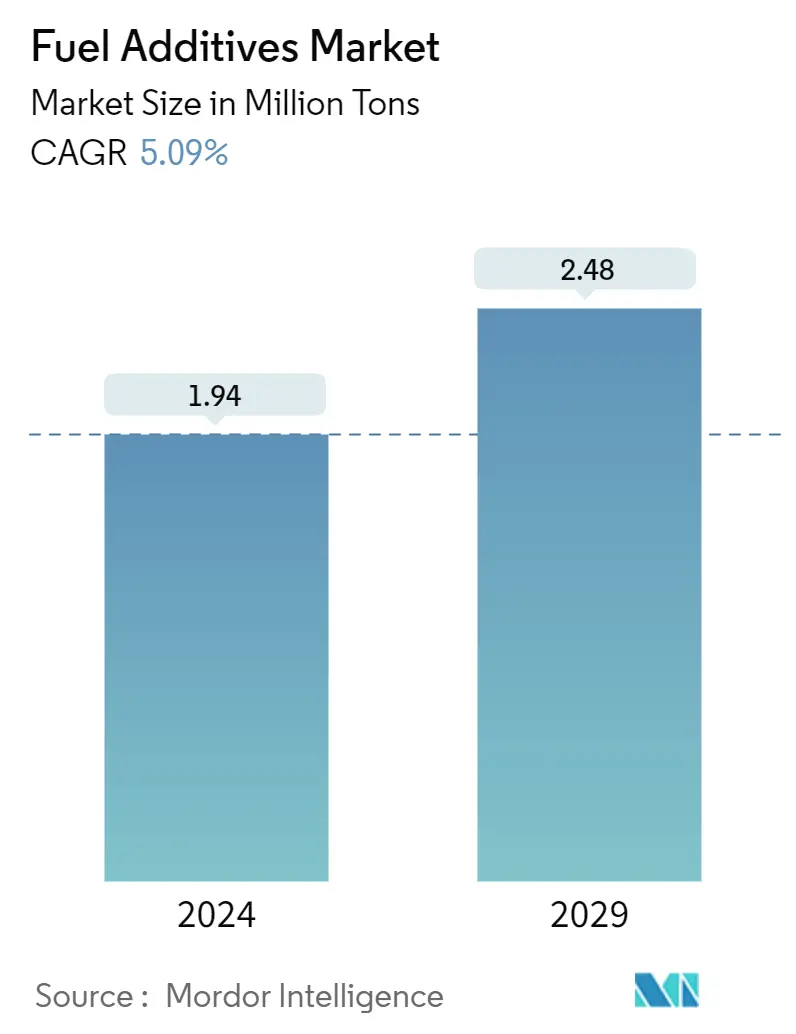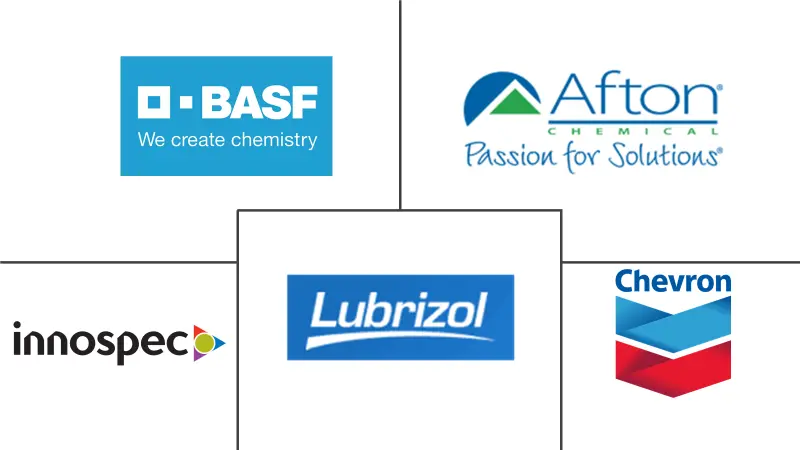Market Size of Fuel Additives Industry

| Study Period | 2019 - 2029 |
| Base Year For Estimation | 2023 |
| CAGR (2024 - 2029) | 5.09 % |
| Fastest Growing Market | Asia Pacific |
| Largest Market | North America |
| Market Concentration | Low |
Major Players
*Disclaimer: Major Players sorted in no particular order |
Fuel Additives Market Analysis
The Fuel Additives Market size is estimated at 1.94 Million tons in 2024, and is expected to reach 2.48 Million tons by 2029, growing at a CAGR of 5.09% during the forecast period (2024-2029).
The COVID-19 pandemic negatively impacted the market. This was because of the shutdown of manufacturing facilities and plants due to the lockdown and restrictions. Supply chain and transportation disruptions further created hindrances for the market. However, the industry witnessed a recovery in 2021, thus rebounding the demand for the market studied.
- Over the medium term, the enactment of stringent environmental regulations and the degrading quality of crude oil are some of the factors driving the growth of the market studied.
- On the flip side, increasing demand for battery electric vehicles (BEVs) in countries such as the United States, China, and Germany and high cost of R&D activities may hamper the market's growth during the forecast period.
- However, the accelerating demand for ultra-low-sulfur diesel (ULSD) is likely to act as an opportunity for market growth in the future.
Fuel Additives Industry Segmentation
Fuel additives are compounds that are designed to improve the quality and efficiency of fuels. Fuel additives are added to improve performance, flowability, corrosion resistance, clean burning, and many other properties.
The fuel additives market is segmented based on product type, application, and geography. The market is segmented by product type into deposit control, cetane improvers, lubricity additives, antioxidants, anti-corrosion, cold flow improvers, antiknock agents, and other product types. The market is segmented by application into diesel, gasoline, jet fuel, and other applications. On the basis of geography, the market is categorized into Asia-Pacific, North America, Europe, South America, the Middle East, and Africa. The report also covers the market size and forecasts for fuel additives in 15 countries across major regions. For each segment, the market sizing and forecasts have been done based on volume (Tons).
| Product Type | |
| Deposit Control | |
| Cetane Improvers | |
| Lubricity Additives | |
| Antioxidants | |
| Anticorrosion | |
| Cold Flow Improvers | |
| Antiknock Agents | |
| Other Product Types |
| Application | |
| Diesel | |
| Gasoline | |
| Jet Fuel | |
| Other Applications |
| Geography | |||||||
| |||||||
| |||||||
| |||||||
| |||||||
|
Fuel Additives Market Size Summary
The fuel additives market is poised for significant growth over the forecast period, driven by factors such as stringent environmental regulations and the declining quality of crude oil. The market experienced a setback due to the COVID-19 pandemic, which caused manufacturing shutdowns and supply chain disruptions. However, a recovery was observed in 2021, restoring demand. The market's expansion is somewhat tempered by the rising popularity of battery electric vehicles in key markets like the United States, China, and Germany, as well as the high costs associated with research and development. Nonetheless, the increasing demand for ultra-low-sulfur diesel presents a promising opportunity for future growth. Gasoline additives, which enhance the octane number and improve fuel performance, are expected to dominate the market, particularly in automotive and aviation applications.
In the North American region, the United States stands out as a dominant player in the fuel additives market, bolstered by its robust manufacturing sector and significant contributions to the global economy. The country's aviation industry has seen a rise in jet fuel consumption, while fuel oil usage has also increased. The United States' position as a leading automotive manufacturer further supports the demand for fuel additives. The fragmented nature of the market is characterized by key players such as Afton Chemicals, The Lubrizol Corporation, Innospec, Chevron Corporation, and BASF SE, who are actively expanding their capabilities and product offerings to meet the growing demand. Recent developments, such as Afton Chemical's advancements in diesel fuel detergent technology and the expansion of its manufacturing facility in Singapore, highlight the industry's focus on enhancing fuel performance and optimizing supply chain solutions.
Fuel Additives Market Size - Table of Contents
-
1. MARKET DYNAMICS
-
1.1 Drivers
-
1.1.1 Enactment of Stringent Environmental Regulations
-
1.1.2 Degrading Quality of Crude Oil
-
-
1.2 Restraints
-
1.2.1 Increasing Demand for Battery Electric Vehicles (BEVs)
-
1.2.2 High Costs of R&D Activities
-
-
1.3 Industry Value Chain Analysis
-
1.4 Porter's Five Forces Analysis
-
1.4.1 Bargaining Power of Suppliers
-
1.4.2 Bargaining Power of Buyers
-
1.4.3 Threat of New Entrants
-
1.4.4 Threat of Substitute Products and Services
-
1.4.5 Degree of Competition
-
-
-
2. MARKET SEGMENTATION (Market Size by Volume)
-
2.1 Product Type
-
2.1.1 Deposit Control
-
2.1.2 Cetane Improvers
-
2.1.3 Lubricity Additives
-
2.1.4 Antioxidants
-
2.1.5 Anticorrosion
-
2.1.6 Cold Flow Improvers
-
2.1.7 Antiknock Agents
-
2.1.8 Other Product Types
-
-
2.2 Application
-
2.2.1 Diesel
-
2.2.2 Gasoline
-
2.2.3 Jet Fuel
-
2.2.4 Other Applications
-
-
2.3 Geography
-
2.3.1 Asia-Pacific
-
2.3.1.1 China
-
2.3.1.2 India
-
2.3.1.3 Japan
-
2.3.1.4 South Korea
-
2.3.1.5 Rest of Asia-Pacific
-
-
2.3.2 North America
-
2.3.2.1 United States
-
2.3.2.2 Canada
-
-
2.3.3 Europe
-
2.3.3.1 Germany
-
2.3.3.2 France
-
2.3.3.3 United Kingdom
-
2.3.3.4 Italy
-
2.3.3.5 Rest of Europe
-
-
2.3.4 South America
-
2.3.4.1 Brazil
-
2.3.4.2 Mexico
-
2.3.4.3 Argentina
-
2.3.4.4 Rest of South America
-
-
2.3.5 Middle-East and Africa
-
2.3.5.1 Saudi Arabia
-
2.3.5.2 South Africa
-
2.3.5.3 Rest of Middle-East and Africa
-
-
-
Fuel Additives Market Size FAQs
How big is the Fuel Additives Market?
The Fuel Additives Market size is expected to reach 1.94 million tons in 2024 and grow at a CAGR of 5.09% to reach 2.48 million tons by 2029.
What is the current Fuel Additives Market size?
In 2024, the Fuel Additives Market size is expected to reach 1.94 million tons.

